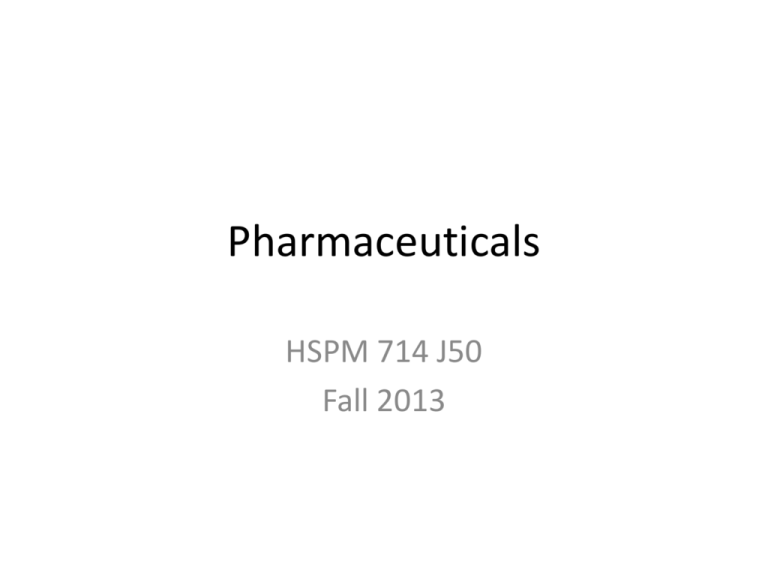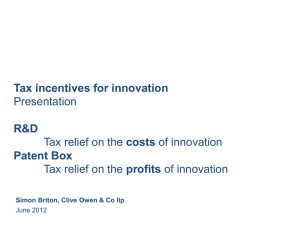Pharmaceuticals
advertisement

Pharmaceuticals HSPM 714 J50 Fall 2013 What is the real product of the drug industry? • Drugs? • New drugs? • Prices >> marginal cost of production – for brand name drugs Drug Companies’ Cost Structure Marketing and Admin 35% R&D 13% Manufacturing 27% Profits (After Taxes) 18% Source: Health Affairs 2001;20(5):136 Source: Health Affairs 2001;20(5):136 Why are brand-name drug prices so much higher than production cost? • WRONG: Industry passes R&D cost on in the price. • RIGHT: Demand determines the price. Industry spends on R&D to create drugs that can be sold at a high price. Profits and innovation • Today's profits do not pay for yesterday's research. • Yesterday's research costs do not determine today's drug prices. • Rather, today's drug prices are set by what the market will bear, and the research and development effort adjusts. What do drug industry profits do? • Today's profits are not the fund that pays for tomorrow's research. – Established drug firms do pay for research out of their operating profit, but many biotechnology startup companies raise capital by borrowing or selling stock. If the expected returns were good enough, the drug companies could do that, too. • What today's profits do: influence expectations about tomorrow's profits. Expected future profit induces today's research and development. Example, from Angell • ‘… the price of Schering-Plough’s top-selling allergy pill, Claritin, was raised thirteen times over five years, for a cumulative increase of more than 50 percent—over four times the rate of general inflation.2 As a spokeswoman for one company explained, “Price increases are not uncommon in the industry and this allows us to be able to invest in R&D.”’ R&D (almost) expands to meet profit opportunity – U.S. Congress, Office of Technology Assessment, Pharmaceutical R&D: Costs, Risks, and Rewards, OTA-H-522 (Washington, DC: U.S. Government Printing Office, February 1993) • Pharmaceutical R&D* is risky and requires extra return. (* D includes education.) • Pharmaceutical companies made more profit than necessary to compensate them for the risk, but only by 4.3% of drug prices, on average. Would limiting drug prices reduce innovation? • The danger of forcing drug prices down today is that drug firms will expect less payoff from drugs in the future. They will reduce research and development accordingly. • What's unclear, though, is how much that research reduction will be, and whether any reduction would retard actual scientific advance, as opposed to the pursuit of "metoo" drugs. Angell’s critique: “Me too” drugs • Little or no therapeutic difference with existing drugs. • Doctors can be persuaded to prescribe them anyway. • Only some price competition. Net Cost ------------------- is the cost-effectiveness measure QALY Cost = Price × Quantity – Saved treatment cost $135.45×Quantity – Saved treatment cost --------------------------------------------- = $43,600/qg QALYs gained ($135.45 is for one HPV Quad) Our government’s systems for encouraging drug innovation • Patents • Regulation Patents • U.S. Constitution, Article I, section 8: • Congress shall have Power … [to do several things, including] To promote the Progress of Science and useful Arts, by securing for limited Times to Authors and Inventors the exclusive Right to their respective Writings and Discoveries; … Patents’ purpose • Patents induce invention – by the prospect of profit during the monopoly period. • Patents help disseminate technology – by making patents public documents – and by ending the monopoly after a set number of years. What gets a patent – A patent can be granted for • “any new and useful art, machine, manufacture or composition of matter and any new and useful improvement on any art, machine, manufacture or composition of matter.” – Secretary of State Thomas Jefferson, 1793 Relevant to the drug industry • Product patent – A new drug entity (invented molecule or mixture) • Process patent – A new method for manufacturing a drug entity • Use patent Patents terminology PATENT • Granted by the U.S. Patent and Trademark Office (USPTO). • Gives the owner the right to exclude others from making, using, or selling an invention for a fixed period of time. • Requires that the details of the invention be made public. PATENT LIFE or PATENT TERM • The period of time during which a patent is in effect. Currently 20 years, beginning on the date of application to the USPTO. EFFECTIVE PATENT LIFE • Portion of the patent term that remains after clinical testing and FDA review. Intellectual Property Protection (IPP) Tactics As a drug’s patent nears expiration … EVERGREENING • Patenting additional uses of a drug or a “purified” form of the drug. “PURIFIED” DRUG • Alter a drug’s molecular structure, supposedly to enhance effectiveness or to reduce side effects and dangerous interactions. Regulation • 1906 Pure Food and Drug Act. – "U.S.P." standard established for purity. – No safety or efficacy requirement. – Required labeling of products containing certain specified drugs, including alcohol, cocaine, heroin, morphine, and cannabis • Upton Sinclair, The Jungle, 1906 – “I aimed for America's heart, but I hit its stomach.” Regulation • 1938 Federal Food, Drug, and Cosmetics Act • Created the Food and Drug Administration (FDA). • Marketing new drug has since required prior approval of New Drug Application (NDA). • Safety was the criterion for approval. – 1937 -- an elixir of Sulfanilamide dissolved in ethylene glycol killed over 100 children Invention of modern drug marketing • Aureomycin 1948 – American Cyanamid • Fawning ghost-written articles in magazines • Direct mailings to doctors • Samples 1962: Regulation tightened 1962: Regulation tightened – 1960-62 Thalidomide incident sparked the 1962 Kefauver-Harris Amendments • Positive NDA approval required, no time limit • Proof of efficacy required, in addition to proof of safety • Retroactive efficacy proof required for post-1938 drugs – Led to removals from market of about 90 senseless drugs, like antibiotics in combination. • Clinical testing tightened – animal tests first – then IND (Investigational New Drug) application – controlled clinical tests by qualified investigators • Advertising restrictions – generic name must appear – side-effects and contraindications – therapeutic claims cannot exceed evidence submitted to FDA Attack on regulation began in late 1960s • New FDA process made pharmaceutical innovation more costly • While reducing the future income stream by using up some of the patent years • Drug prices determined by demand elasticity – what market will bear Alleged consequences of regulation’s cost and time • … Promising drugs are not developed, or our access to them is delayed • Oft-cited example: benzodiazepine hypnotics. – Available in the U.S. 5 years after available in Europe. – Estimate of 1200 deaths from reactions to barbiturates during those years that would not have happened had drugs of this class been available. Hatch-Waxman Act • The Drug Price Competition and Patent Term Restoration Act of 1984 • Generics can win FDA approval by submitting bioequivalence studies, as opposed to clinical trials data. • Grants patented drugs up to 5 years of additional marketing exclusivity to make up for the time consumed by the clinical trials and approval process. Prescription Drug User Fee Act (PDUFA) • Enacted 1992, renewed in 1997, 2002, 2007. • FDA can collect fees from companies that produce certain human drug and biological products to help pay for reviewers. • NEW FORMULATION: new dosage or new formulation of active ingredients for drug already on the market. • NEW COMBINATION: drug containing two or more compounds which have been marketed before, but not together as one. • NEW MANUFACTURER: company creating product with the same active ingredients or formulation as another manufacturer. • NEW MOLECULAR ENTITY: compound which has never been sold before in the U.S. Oligopoly in certain drug markets BiDil • http://en.wikipedia.org/wiki/Isosorbide_dinitr ate/hydralazine • http://www.nitromed.com/ • Patented use – prescription to AfricanAmericans • Neurontin -- promotion of off-label uses. Cultivating doctors. 1997-2004 Fraud/Civil Fines Against Drug Firms Roche & BASF •>$725 M •Price fixing cartel Noll •$135 M •Suppressing Synthroid research data TAP Pharmaceuticals •$875 M •Criminal kickbacks, Lupron Schering-Plough •$500 M (poor quality) •$345 M + $435 M (fraud) Bayer •$257 M •Criminal Medicaid fraud Purdue Pharma •$600 M •Claimed OxyContin less addictive Pfizer •$430M & $2.3B •Illegal marketing Neurontin/Bextra Novartis •$422 M •Illegal marketing Trileptal Eli Lilly •$1.4 B •Illegal marketing Zyprexa Bristol Meyers Squibb •$515 M •Illegal marketing Abilify Allergan •$600 M •Illegal marketing Botox Pfizer •$430M & $2.3B •Illegal marketing Neurontin/Bextra Astra Zeneca •$520 M •Illegal marketing Seroquel Forest Labs •$313 M •Illegal marketing Lexapro/Celexa Glaxo Smith Kline •$750 M •Defective manufacturing (Paxil) Sources: Sources: NYT NYT 7/30/97, 7/30/97, 10/10/99, 10/10/99, 1/20/00, 1/20/00, 2/4/00, 2/4/00, 5/18/02, 5/18/02, 4/17/03, 4/17/03, 8/30/06, 8/30/06, 5/11/07, 9/3/09; Mod HCr 3/25/96, 3/3/97, 10/8/01, 6/30/08, 5/11/07, 9/3/09; Mod HCr 3/25/96, 3/3/97, 10/8/01, 6/30/08, 10/1/10, 10/1/10, 10/27/10; 10/27/10; Nation Nation 4/7/97; 4/7/97; DHHS DHHS IG; IG; Phil Phil Inq Inq 7/30/04; 7/30/04; USA USA Today Today 5/14/04 5/14/04 Angell and • Outrageous prices for me-too drugs • Vioxx as example of unneeded heavilypromoted drug • Reforms needed to get rid of conflict of interest affecting doctors and regulators Gladwell • It's volume, not price. – Generics are cheaper here. • Docs -- knowledgeable professionals acting as patients’ agents -prescribed it. • Benefits managers will solve it. Free riders? Percentages of world activity In 2003 Sales R&D NMEs U.S. 48% 49% 45% Europe 28% 36% 32% Sleeping Sickness • http://www.who.int/mediacentre/factsheets/f s259/en/index.html • Eflornithine http://www.vaniqa.com/




